-
Posts
1,193 -
Joined
-
Last visited
-
Days Won
4
Content Type
Profiles
Forums
Blogs
Gallery
Events
Store
Posts posted by Deutschritter
-
-
Gentlemen, this is what I have for Karl Gottfried Friedrich Peter Freiherr von Forstner (1790–1857), if anyone can add anything, that would be great:
Knight of the Legion of Honour (FEL5/FE5) on 18 August 1812
Mecklenburg Military Merit Medal for 1813/1815 (MMV) in Gold
Swedish Order of the Sword, Knight's Cross (SS3)
... Later classified as SS3a, Knight Grand Cross First Class.[9] Normally, SS3a stands for Knight's Cross 1st Class, In the event of war, there was a separate decoration (created 1788), the Knights of the Grand Cross of the Order of the Sword, 1st and 2nd Class, which was only awarded for merit against the enemy. The medal could also be awarded in the event of a serious wound or when an enemy victory symbol (e.g. flag) was captured.
Iron Cross (1813), 2nd Class
Prussian War Commemorative Medal for the Wars of Liberation (Kriegsdenkmünze für die Befreiungskriege)
Russian Order of St. George, 5th Class (RG5) in September 1823
Red Eagle Order (Roter Adlerorden), 4th Class (PRAO4/PrA4)
Prussian Long Service Cross for 25 years (Königlich Preußisches Dienstauszeichnungskreuz; DA)
Red Eagle Order, 3rd Class with the Bow
Knight (Ritter; Rr) of the Johanniter-Orden in September 1841
Hesse House Order of the Golden Lion, Grand Cross (CHL1) in June 1845
Red Eagle Order, 2nd Class with Oak Leaves in January 1846
1 -
Who is the officer in the picture behind the Pickelhaube? Thanks!!!
0 -
3 minutes ago, David M said:
The GGT are online as well? Or do you have access to them in a library close to you?
Some are online, some are at FamilySearch, membership is free. https://wiki.genealogy.net/Gothaisches_Genealogisches_Taschenbuch
2 -
One more thing, David: I know, Ludewig von Bastineller is often considered commander of the 11. Husaren-Regiment for a short term (Geschichte des 2. Westfälischen-Husaren-Regiments Nr. 11 und seiner Stammtruppen von 1807–1893), but the Rangliste 1835 and 1836 do not show this, they show him in the staff. What happened? August Ferdinand von Glaser was named commander on 1 December 1823 and arrived at regiment headquarters on 6 February 1824. I assume, he fell ill in 1834, he retired with the Charakter als Generalmajor on 14 October 1934. Maybe von Bastineller was delegated with the leadership for a short while in 1834/1835, but even the Rangliste from this year shows Carl Friedrich Freiherr von Forstner (officially as of 4 April 1835) as aggregiert and ad interim Führer des Regiments. Freiherr von Forstner was officially appointed commander on 30 March 1836. Do you know more about this? Any information would be great.
0 -
Yes, David:
Gothaisches Genealogisches Taschenbuch der Adeligen Häuser, Teil B, 1928, p. 26
Gothaisches Genealogisches Taschenbuch der Adeligen Häuser, Teil B, 1940, p. 22
0 -
Yes, of course, David ... keep up the great work! Let me add a couple of things: Gotha 1928 and 1940 both have his birth name as Alexander Christian Ludewig von Bastineller and death place Münster (7. Brigade), which would make sense. Carl Gottlob (1764–1830) as of Gotha. Not Gottlieb and not 1767. Biographisches Handbuch der preußischen Verwaltungs- und Justizbeamten 1740-1806/15 (p. 44) writes, Carl Gottlob tried to enter the Prussian Army, but was refused. Carl Gottlob was also made a Freiherr/Baron of the Kingdom of Westphalia on 13 May 1813, this was although not recognized by Prussia therefore never listed.
https://babel.hathitrust.org/cgi/pt?id=mdp.39015004080944&seq=366&q1=Bastineller+&start=1
0 -
I would have to guess, no. Ludwig served with the Hesse-Kassel Army, then as of 1806 with the Duchy of Weimar (1806 Kammerjunker, 1811 Kammerherr) and of 1812 with the Prussian cavalry, becoming Major in 1834. Your Bastineller is Carl Gottlob von Bastineller (older brother, b. 1764), Oberst in 1812 and Brigadegeneral in 1813, fighting for the French because the regiment belonged to the Kingdom of Westphalia. Both Carl Gottlob (Flügel-Adjutant) and Ludwig originally served with the Hesse-Kassel Regiment Gens d'Armes.
0 -
As of the Rangliste 1850, he was Oberst and Brigadier of the Land-Gendarmerie (7. Brigade. Münster) with RAO4 and DAK. It can be assumed, that he also received the Kriegsdenkmünze für die Befreiungskriege (Preußen).
0 -
3 hours ago, seeheld said:
Sorry, I forgot the 1st Class...
Mecklenburg-Schwerin:
Nerger, Karl-August Theodor Julius
Kapitänleutnant, Chef der 7. Minensuch-Flottille
MVK1 - 06.11.1917
Regards Seeheld
This might be a small mix-up, Karl August Nerger was already Korvettenkapitän in 1911 and Fregattenkapitän in 1917. Kapitänleutnant and Chef of the 7. Minensuch-Flottille was his brother Johann "Hans" Maximilian Nerger. Maybe Karl-August (actually Karl August?!) received his MVK1 (much) earlier? Thanks!!!
1 -
This is really great, thank you very much, Gentlemen!!!
0 -
13 hours ago, David M said:
So his final prussian odm
ROA4
DAK
EK2
I would add:
War Commemorative Medal of 1870–1871 (Kaiserliche Kriegsdenkmünze 1870/71; KD70/71) in Bronze
Anniversary Oak Leaves (Jubiläums-Eichenlaub „25“ 1870/1895) to his Iron Cross (1870), 2nd Class
0 -
-
So he served in the same regiment as his brother Karl Otto Hermann Wilhelm Wolfgang Ziegler. Thank you, Dave!
0 -
Gentlemen, does anyone have a death date (> 1934) Thanks!
0 -
Thank you! I still cannot believe, no one knows in which unit(s) he served with in WWI. But I will not give up hope.
Many greetings,
Andreas
0 -
-
Thank you, Dave, great! Can you add any decorations by identifying the ribbon bar? Thanks!
0 -
-
Thanks ... too bad about the birth/death dates ... maybe someone else can help us out.
13 August 1879 Charakter als Oberst z. D.
0 -
Gentlemen, I am not sure, if this is the correct category, but I need help with a rank: The Stabshauptmann, as we understand it today, even with the Bundeswehr, was/is a rank between Oberleutnant and Hauptmann (I. Klasse), often historically classified as Hauptmann II. Klasse. In Bavaria around 1866-68, officers like Benignus von Safferling (8. Jäger-Bataillon) and others, already Hauptmann I Klasse, would be promoted (appointed?) to/as Stabshauptmann, although the Ranglisten still showed them as Hauptmann I Klasse. Therefore my question: Was the Stabshauptmann not a rank at all but instead a Dienstbezeichnung (job title)? Maybe the senior Hauptmann I Klasse, not leadig a company, but placed into a battalion staff as deputy of a major? Thanks for any information!
0 -
Very nice picture, Giannis! Is that the Oberst z. D. Ziegler who commanded the Landwehr-Bezirks-Kommando Speyer and retired 16 December 1886? Do you have any further dates? Complete name, birth date, death date, marriage, children etc? I would love to know more!
Thanks!
Andreas
0 -
Gentlemen, this is what I have on Franz Ritter von Hipper, any additions or corrections would be great. Thanks!
15 April 1881 Kadett (Officer Candidate; Crew 81)
... Among others, the later admirals Richard Eckermann, Konrad Trummler, Friedrich Schultz, Karl Zimmermann, Christian Schütz and Wilhelm Sthamer belonged to this Crew.
16 May 1882 Seekadett (Officer Cadet)
21 November 1884 Unterleutnant zur See (2nd Lieutenant) without Patent
19 December 1885 Patent received
23 June 1888 Leutnant zur See (1st Lieutenant)
14 January 1895 Kapitänleutnant (Lieutenant Captain) subject to patentability (Vorbehalt der Patentierung)
11 November 1895 Patent received with Rank Seniority (RDA) from 14 Januar 1895
10 June 1901 Korvettenkapitän (Corvette Captain – Lieutenant Commander)
5 April 1905 Fregattenkapitän (Frigate Captain – Commander)
6 April 1907 Kapitän zur See (Captain at Sea – Captain)
27 January 1912 Konteradmiral (Rear Admiral)
17 June 1915 Vizeadmiral (Vice Admiral)
11 August 1918 Admiral
... He resigned from his post on 30 November 1918, was granted leave of absence until 13 December 1918, and then, at his request, was put at disposal (de facto retired).
Prussian Centenary Medal 1897 (Zentenarmedaille)
Red Eagle Order (Roter Adlerorden), 4th Class
Military Merit Order (Bavaria), Knight's Cross 1st Class (BMV3a)
Imperial Russian Sankt-Stanislaus-Orden, II. Klasse (RSt2)
Prussian Long Service Cross for 25 years (Königlich Preußisches Dienstauszeichnungskreuz; DA)
Crown to his Red Eagle Order 4th Class
Order of the White Falcon (Hausorden vom Weißen Falken), Knight's Cross 1st Class (GSF3a)
Prussian Order of the Crown (Preußischer Kronenorden), 3rd Class
Military Merit Order (Bavaria), 3rd Class (BMV3)
Royal Norwegian Order of Saint Olav, Commander II. Class (NO2b)
Russian Order of Saint Anna (Sankt-Annen-Orden), 2nd Class (RA2)
Red Eagle Order, 3rd Class with the Bow (mit der Schleife)
Prussian Order of the Crown, 2nd Class
Military Merit Order (Bavaria), 2nd Class (BMV2)
Bronze Prinzregent Luitpold Medal on the anniversary medal ribbon from 1911 (BLM3J) on 12 April 1913
Red Eagle Order, 2nd Class with Oak Leaves
WWI
Iron Cross (1914), 2nd and 1st Class
Oldenburg Friedrich-August-Kreuz, Second and First Class (OFA1/OK1)
Military Merit Order (Württemberg), Commander (WMV2)
Star and Swords to his Military Merit Order (Bavaria) 2nd Class (BMV2mSt⚔)
Pour le Mérite on 5 June 1916 as Vice Admiral
Military Order of Max Joseph, Commander's Cross (BMJ2) on 6 June 1916 as Vice Admiral
... This meant, together with the order, that he was elevated to personal nobility and, after being registered in the nobility register, he was allowed to call himself "Ritter von Hipper".
Großherzoglich Mecklenburg-Schwerinsches Militärverdienstkreuz, II. Class (MMV2/MK2)
Bremen Hanseatic Cross (Bremisches Hanseatenkreuz; BremH/BH)
Hamburg Hanseatic Cross (Hamburgisches Hanseatenkreuz; HH)
Lübeck Hanseatic Cross (Lübeckisches Hanseatenkreuz; LübH/LüH)
Swords to his Red Eagle Order 2nd Class with Oak Leaves
Albrechts-Orden of Saxony, Commander (Komtur) II. Class with Star and Swords (SA2bmSt⚔)
Star with Swords to his Red Eagle Order 2nd Class with Oak Leaves and Swords
Order of the Iron Crown (Austria), 1st Class with the War Decoration (ÖEK1K)
1 -
On 30/04/2013 at 19:12, Deruelle said:
Major Erich Krebs
Oberst Erich Krebs (PLM): If you can add anything, that would be great. Thanks!
0 -
Gentlemen, this is what I have for Friedrich Wilhelm Erich Krebs, any additions or corrections would be great, especially WWI decorations. I am sure, I am missing several:
?? Fahnenjunker
?? Portepee-Fähnrich (Officer Cadet)
18 January 1891 Sekondeleutnant (2nd Lieutenant)
18 April 1899 Oberleutnant (1st Lieutenant)
18 July 1905 Hauptmann (Captain)
19 July 1913 Major
15 July 1918 Oberstleutnant (Lieutenant Colonel)
9 April 1920 Retired mit dem Charakter als Oberst (Honorary Colonel)
Prussian Centenary Medal 1897 (Zentenarmedaille)
Mecklenburg Order of the Griffon (Großherzoglich Mecklenburgischer Greifenorden), Knight's Cross with the Crown (MG3mKr)
Red Eagle Order (Roter Adlerorden), 4th Class
Military Merit Order (Bavaria), 4th Class with the Crown (BMV4mKr)
Prussian Long Service Cross for 25 years (Königlich Preußisches Dienstauszeichnungskreuz)
Iron Cross (1914), 2nd and 1st Class
Oldenburg Friedrich-August-Kreuz, Second and First Class (OK1)
Gallipoli Star (Eiserner Halbmond; TH)
House Order of Hohenzollern, Knight's Cross with Swords (HOH3⚔)
Pour le Mérite on 23 December 1917 as Major and Commander of the Reserve-Infanterie-Regiment 27/54. Infanterie-Division
Wound Badge (Verwundetenabzeichen 1918) in Mattweiß (Silver)
0



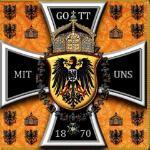
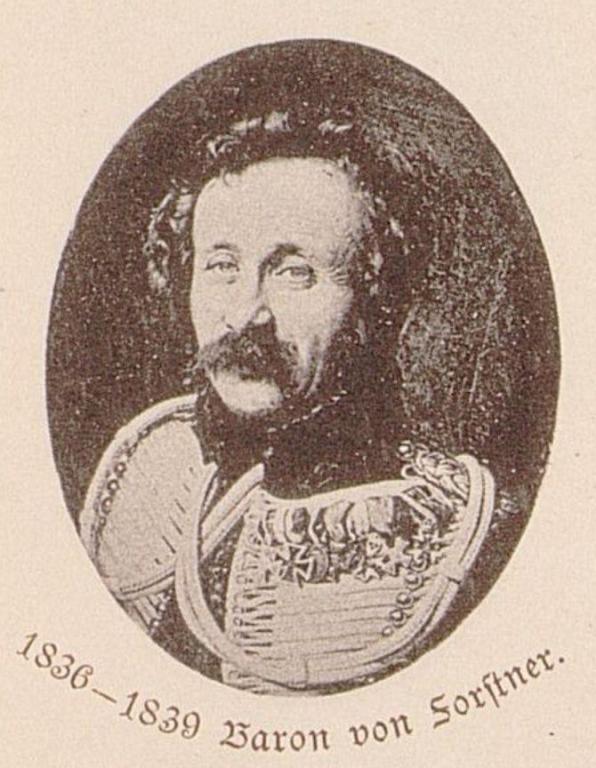
.png.d3b8b913e509bf1cdadf6317b95397d3.png)

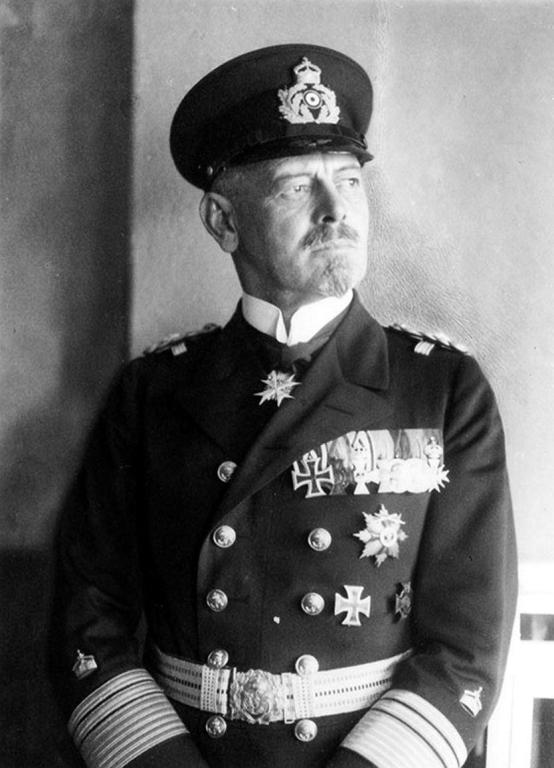
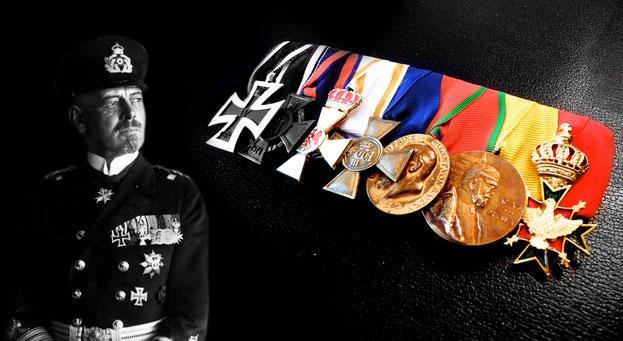
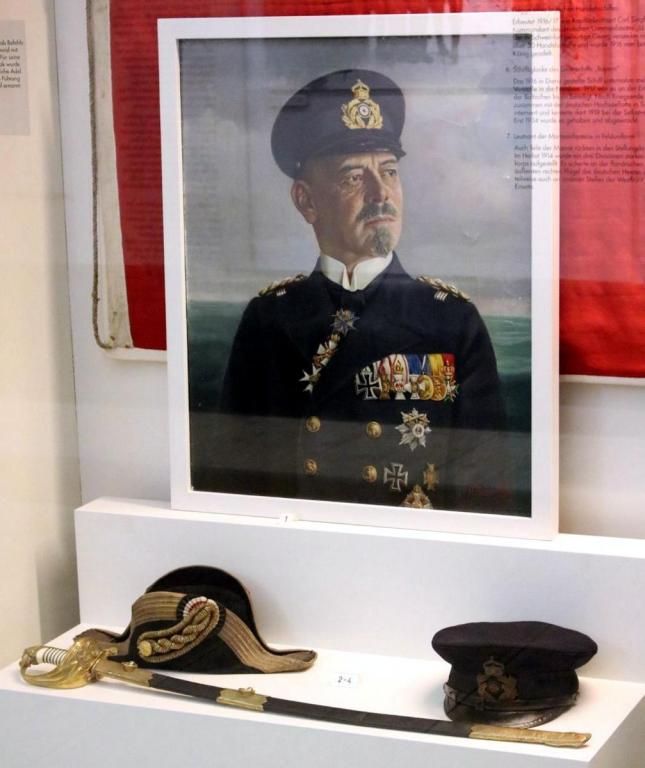



GM Karl Gottfried Friedrich Peter Freiherr von Forstner
in Germany: Imperial: The Orders, Decorations and Medals of The Imperial German States
Posted · Edited by Deutschritter
Yes, phantastic! He served with the Mecklenburg Army from 1804 to 1810, with the Saxon Army from 1810 to May 1813, returning to Mecklenburg as a Stabsrittmeister (Captain 2nd Class) and joining the volunteer riding Jäger corps (freiwilliges Jägerkorps zu Pferde) fighting alongside the Mecklenburg-Strelitzisches Husaren-Regiment. At Sehestedt, he was so badly wounded to the head that he later received permission to always wear a shako (Tschako) because of his head wound. He joined the Prussian Army on 1 June 1815.